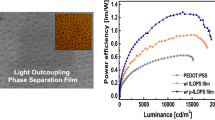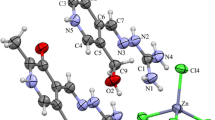Abstract
Poly(9,9-di-n-octylfluorenyl-2,7-diyl) (PFO), referred to as light-emitting polymer, was utilized in this study to synthesize thin films for polymer light-emitting applications (PLED). Three thin films named P1, P2 and P3 refer to three different ways of film fabrication. P1 consists of only PFO, P2 consists of brilliant blue FCF blend PFO, while P3 consists of PFO on polyaniline conductive layer; all these thin films were deposited onto ITO-coated glass substrates (20 Ω) using Doctor blade method. Toluene had been used as the solvent of PFO material. P1 exhibits the smoothest surface (6.43 nm), which is consistent with the FESEM result. The surface roughness increases dramatically in the case of P2 (63.00 nm) with the presence of valleys and high peak protuberance. The surface roughness continues to significantly increase (152.00 nm) with deeper valleys for P3. PL intensity of the thin films was found to be dependent on the structural properties, chemical composition and optical features of these films. Film absorption was shown to increase with surface roughness, resulting in increased PL intensity and replacement of chemical bonds. P3 exhibited the highest PL intensity at 439.7 nm, which is attributable to the relatively lower amount of oxygen in the film structure, increasing both surface roughness and absorption of the film, in addition to the substitution of chemical bonds. P2 displayed higher PL intensity than that of P1 as well. Thus, PFO blend and using a polyaniline conductive layer in the PFO film structure enhance the PL intensity, thereby improving the applicability of PFO films-based polymer light-emitting diodes (PLED).







Similar content being viewed by others
References
Cao X et al (2017) CN-Containing donor–acceptor-type small-molecule materials for thermally activated delayed fluorescence OLEDs. J Mater Chem C 5(31):7699–7714
Konidena RK et al (2018) Tuning the photophysical and electroluminescence properties in asymmetrically tetrasubstituted bipolar carbazoles by functional group disposition. ACS Appl Mater Interfaces 10(28):24013–24027
Joseph V et al (2018) Tetra-substituted Dipolar Carbazoles: tuning optical and electroluminescence properties by linkage variation. Asian J Org Chem 7(8):1654–1666
Wex B, Kaafarani BR (2017) Perspective on carbazole-based organic compounds as emitters and hosts in TADF applications. J Mater Chemstry C 5(34):8622–8653
Joseph V et al (2018) Vinyl-linked cyanocarbazole-based emitters: effect of conjugation and terminal chromophores on the photophysical and electroluminescent properties. ACS Omega 3(12):16477–16488
Van der Zee B et al (2022) Efficiency of polymer light-emitting diodes: a perspective. Adv Mater 34(13):2108887
Burroughes JH et al (1990) Light-emitting diodes based on conjugated polymers. Nature 347(6293):539–541
Gopikrishna P, Das D, Iyer PK (2017) Color tunable donor-acceptor electroluminescent copolymers: synthesis, characterization. Photophys Prop PLED Fabr ChemistrySelect 2(24):7044–7049
Al-Asbahi BA et al (2013) Influence of TiO 2 nanoparticles on enhancement of optoelectronic properties of PFO-based light emitting diode. J Nanomater 2013:130
Lim WF, Quah HJ, Hassan Z (2016) Effects of annealing temperature on optical, morphological, and electrical characteristics of polyfluorene-derivative thin films on ITO glass substrate. Appl Opt 55(6):1198–1205
Palilis LC et al (1999) Bright and efficient blue light-emitting diodes based on conjugated polymer blends in organic light-emitting materials and devices III. Int Soc Opt Photonics 3797:383–397
Fallahi A et al (2014) A novel ambipolar polymer: from organic thin-film transistors to enhanced air-stable blue light emitting diodes. J Mater Chem C 2(32):6491–6501
Heydari R, Hosseini M (2016) A simple method for simultaneous spectrophotometric determination of brilliant blue fcf and sunset yellow fcf in food samples after cloud point extraction. J Chem Soc Pak 38(3):438–445
Wang CC, Masi AN, Fernández L (2008) On-line micellar-enhanced spectrofluorimetric determination of rhodamine dye in cosmetics. Talanta 75(1):135–140
Vidotti EC et al (2005) Simultaneous determination of food dyes by first derivative spectrophotometry with sorption onto polyurethane foam. Anal Sci 21(2):149–153
Dharmadasa I, Burton R, Simmonds M (2006) Electrodeposition of CuInSe2 layers using a two-electrode system for applications in multi-layer graded bandgap solar cells. Sol Energy Mater Sol Cells 90(15):2191–2200
de Azevedo D et al (2017) Correlation between the PL and EL emissions of polyfluorene-based diodes using bilayers or polymer blends. Synth Met 233:28–34
Perevedentsev A et al (2015) Solution-crystallization and related phenomena in 9, 9-dialkyl-fluorene polymers. I Crystalline polymer-solvent compound formation for poly (9, 9-dioctylfluorene). J Polym Sci Part B: Polym Phys 53(21):1481–1491
Mostafaei A, Zolriasatein A (2012) Synthesis and characterization of conducting polyaniline nanocomposites containing ZnO nanorods. Prog Nat Scince: Mater Int 22(4):273–280
Bera A et al (2017) Flexible diode of polyaniline/ITO heterojunction on PET substrate. Appl Surf Sci 418:264–269
Jang S et al (2015) Multifunctional graphene optoelectronic devices capable of detecting and storing photonic signals. Nano Lett 15(4):2542–2547
Ko S-J et al (2013) Highly efficient plasmonic organic optoelectronic devices based on a conducting polymer electrode incorporated with silver nanoparticles. Energy Environ Sci 6(6):1949–1955
Choy WC, Chan WK, Yuan Y (2014) Recent advances in transition metal complexes and light-management engineering in organic optoelectronic devices. Adv Mater 26(31):5368–5399
Zhao Y et al (2015) Anomalously large interface charge in polarity-switchable photovoltaic devices: an indication of mobile ions in organic–inorganic halide perovskites. Energy Environ Sci 8(4):1256–1260
Sharma A et al (2015) Electronic and chemical properties of ZnO in inverted organic photovoltaic devices. Org Electron 24:131–136
Wang J et al (2015) Solution synthesized p-type copper gallium oxide nanoplates as hole transport layer for organic photovoltaic devices. The J Phys Chem Lett 6(6):1071–1075
Kudo K et al (2000) Organic static induction transistor for display devices. Synth Met 111–112:11–14
Alassod A, Abedalwafa MA, Xu G (2021) Evaluation of polypropylene melt blown nonwoven as the interceptor for oil. Environ Technol 42(18):2784–2796
Alassod A et al (2022) Polypropylene-chitosan sponges prepared via thermal induce phase separation used as sorbents for oil spills cleanup. Polym Bull 80(5):4949–4964
Alassod A et al (2021) Polypropylene/Lignin/POSS nanocomposites: thermal and wettability properties, application in water remediation. Materials 14(14):3950
Shinde DV et al (2014) A coordination chemistry approach for shape controlled synthesis of indium oxide nanostructures and their photoelectrochemical properties. J Mater Chem A 2(15):5490–5498
Thirumoorthi M, Thomas Joseph Prakash J (2016) Structure, optical and electrical properties of indium tin oxide ultra thin films prepared by jet nebulizer spray pyrolysis technique. J Asian Ceramic Soc 4(1):124–132
Guo X et al (2016) Solution processable organic/inorganic hybrid ultraviolet photovoltaic detector. AIP Adv 6(5):055318
Al-Asbahi BA, Jumali MHH, Al-Gaashani R (2014) Efficient charge transfer mechanism in Polyfluorene/ZnO nanocomposite thin films. J Nanomater 2014:87
Palacios R et al (2010) β-phase morphology in ordered Poly(9,9-dioctylfluorene) nanopillars by template wetting method. Nanoscale Res Lett 6(1):35
Lee HB et al (2018) Dependence of photoluminescence of Bi-doped Y2O3 phosphor thin films on oxygen content in the sputtering atmosphere. Thin Solid Films 650:1–6
Shyam P et al (2016) Structural and magnetic investigations on a wet chemically synthesized nanoscale S= 1/2 spin chain compound–CuSe 2 O 5. J Mater Chem C 4(3):611–621
Jafari MJ, (2017) Application of Vibrational Spectroscopy in Organic Electronics. Linköping University Electronic Press.
Sabah FA et al (2016) Effect of light on the sensitivity of CuS thin film EGFET implemented as pH sensor. Int J Electrochem Sci 11:4380–4388
Sabah FA et al (2016) Sensitivity of CuS and CuS/ITO EGFETs implemented as pH sensors. Appl Phys A 122(9):839
Alifragis Y et al (2005) Anion selective potentiometric sensor based on gallium nitride crystalline membrane. Electroanal: Int J Devot Fundam Pract Asp Electroanal 17(5):527–531
Zhang H et al (2020) Highly luminescent carbon dots as temperature sensors and “off-on” sensing of Hg2+ and biothiols. Dyes Pigments 173:107950
Sabah FA et al (2020) Influence of CuS powder concentration on the construction of hybrid PVA/CuS thin films for polymer light-emitting applications. J Mater Sci: Mater Electron 31(4):3456–3465
Scholtz Ľ, Ladanyi L, Müllerová J (2014) Influence of surface roughness on optical characteristics of multilayer solar cells. Appl Phys 12(6):631–638
Gfroerer TH (2000) Photoluminescence in analysis of surfaces and interfaces. Encyclopedia Anal Chem Appl, Theory Instrument 67:3810
Bijumon C, Kumar VS (2016) Raman, PL and hall effect studies of Cdse thin film deposited by chemical bath deposition. Int J Sci Technol Res 5(05):1–5
Gómez A et al (2014) Optical absorption and visible photoluminescence from thin films of silicon phthalocyanine derivatives. Materials 7(9):6585–6603
Yi S-S et al (2004) Enhanced luminescence of Gd2O3:Eu3+ thin-film phosphors by Li doping. Appl Phys Lett 84(3):353–355
Shim KS et al (2009) Crystallinity and surface roughness dependent photoluminescence of Y1− xGdxVO4: Eu3+ thin films grown on Si (100) substrate. Thin Solid Films 517(17):5137–5140
Zhao Y et al (2016) Supramolecular chirality in achiral polyfluorene: chiral gelation, memory of chirality, and chiral sensing property. Macromolecules 49:3214–3221
Qaid SMH et al (2021) Tuning the optical properties of MEH–PPV/PFO hybrid thin films via the incorporation of CsPbBr 3 quantum dots. Coatings 11(2):154
Acknowledgements
The authors thank the Malaysian Government and Universiti Sains Malaysia (USM) for the research facilities and the Research University (RUI) Grant No: 1001.PFIZIK.8011081 to conduct this work. Our gratitude also goes to the Institute of Nano Optoelectronics Research and Technology (INOR), Universiti Sains Malaysia. FAS would like to thank Universiti Sains Malaysia for the Postdoctoral Fellowship.
Funding
The funding was provided by Universiti Sains Malaysia, (RUI) Grant No: (1001.PFIZIK.8011081), Abdul Razak Ibrahim
Author information
Authors and Affiliations
Corresponding authors
Ethics declarations
Conflict of interest
The authors declare that they have no known competing financial interests or personal relationships that could have appeared to influence the work reported in this paper.
Additional information
Publisher's Note
Springer Nature remains neutral with regard to jurisdictional claims in published maps and institutional affiliations.
Rights and permissions
Springer Nature or its licensor (e.g. a society or other partner) holds exclusive rights to this article under a publishing agreement with the author(s) or other rightsholder(s); author self-archiving of the accepted manuscript version of this article is solely governed by the terms of such publishing agreement and applicable law.
About this article
Cite this article
Sabah, F.A., Razak, I.A., Kabaa, E.A. et al. Influence of blending and conductive layer on the photoluminescence intensity of PFO thin films implemented for polymer light-emitting applications. Polym. Bull. 81, 5613–5626 (2024). https://doi.org/10.1007/s00289-023-04948-6
Received:
Revised:
Accepted:
Published:
Issue Date:
DOI: https://doi.org/10.1007/s00289-023-04948-6




